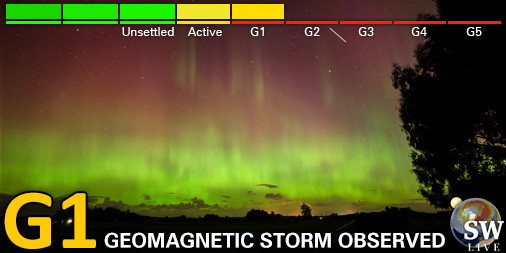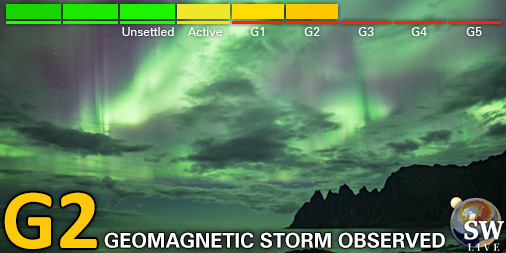Viewing archive of Thursday, 13 September 2001
Solar activity report
Any mentioned solar flare in this report has a scaling factor applied by the Space Weather Prediction Center (SWPC). Because of the SWPC scaling factor, solar flares are reported as 42% smaller than for the science quality data. The scaling factor has been removed from our archived solar flare data to reflect the true physical units.
Report of Solar-Geophysical Activity 2001 Sep 13 2200 UTCPrepared by the NOAA © SWPC and processed by SpaceWeatherLive.com
Joint USAF/NOAA Report of Solar and Geophysical Activity
SDF Number 256 Issued at 2200Z on 13 Sep 2001IA. Analysis of Solar Active Regions and Activity from 12-2100Z to 13-2100Z
Solar activity has been low, however there have been
several C-class flares with associated Type II radio sweeps
indicating potential CME activity. The largest event was a C9.6
x-ray flare at 12/2149 UTC. This event appeared to originate from
Region 9606 (S17W79), per test imagery available from the GOES-12
SXI instrument, and was accompanied by a Type II sweep with
estimated velocity of 747 km/s. Two additional impulsive events
were also observed: A C7/Sn flare at 13/1602 UTC from Region 9610
(S13W18), with associated Type II sweep estimated velocity of 596
km/s, and, again per SXI imagery, a C5.8 x-ray event at 13/1951 UTC
from Region 9607 (S16W51), with associated Type II sweep velocity of
771 km/s. Other C-class flare activity occurred in Regions 9616
(S10E55) and 9608 (S25W33). Two new regions were numbered today:
9618 (S21W26) and 9619 (N17E21).
IB. Solar Activity Forecast
Solar activity is expected to be
moderate to high. Region 9608 remains very large in areal coverage
and spot count, with appreciable magnetic complexity, and remains
capable of producing a major flare. Regions 9610 and 9616 are also
potential sources of M-class activity.
IIA. Geophysical Activity Summary 12-2100Z to 13-2100Z
The geomagnetic field was quiet to active. There were some
indications in the ACE satellite data of a weak interplanetary shock
passage at about 13/0100 UTC. Active geomagnetic conditions and an
isolated period of minor storming at higher latitudes followed, and
persisted for several hours until mainly unsettled conditions
developed from about 13/1200 UTC onward. This disturbance is
presumed to have originated from the CME activity of 9 September.
IIB. Geophysical Activity Forecast
The geomagnetic field is
expected to be quiet to active for the next three days. Shock
passages are expected from the DSF activity of 11 September, and the
CME activity of the past two days, over the course of the forecast
period. Isolated periods of minor storming at higher latitudes are
possible.
III. Event Probabilities 14 Sep to 16 Sep
| Class M | 70% | 70% | 70% |
| Class X | 10% | 10% | 10% |
| Proton | 10% | 10% | 10% |
| PCAF | yellow | ||
IV. Penticton 10.7 cm Flux
Observed 13 Sep 240 Predicted 14 Sep-16 Sep 235/225/225 90 Day Mean 13 Sep 164
V. Geomagnetic A Indices
Observed Afr/Ap 12 Sep 009/013 Estimated Afr/Ap 13 Sep 015/015 Predicted Afr/Ap 14 Sep-16 Sep 018/020-015/015-015/015
VI. Geomagnetic Activity Probabilities 14 Sep to 16 Sep
| A. Middle Latitudes | |||
|---|---|---|---|
| Active | 25% | 20% | 20% |
| Minor storm | 15% | 15% | 15% |
| Major-severe storm | 05% | 05% | 05% |
| B. High Latitudes | |||
|---|---|---|---|
| Active | 30% | 25% | 25% |
| Minor storm | 20% | 15% | 15% |
| Major-severe storm | 05% | 05% | 05% |
All times in UTC
Latest news
Latest forum messages
Incoming & Unnumbered Active Regions 1662Unspecified geomagnetic activity 2222AR4048 114New satellites - Proba-3, PUNCH, SWFO-L1, GOES-U/19 36Filaments and prominences 750
More topicsSupport SpaceWeatherLive.com!
A lot of people come to SpaceWeatherLive to follow the Sun's activity or if there is aurora to be seen, but with more traffic comes higher server costs. Consider a donation if you enjoy SpaceWeatherLive so we can keep the website online!

Latest alerts
10:00 UTC - Hemispheric Power Index
The OVATION model predicts the Hemispheric Power Index to reach 78GW at 10:32 UTC
04:15 UTC - Geomagnetic activity
Minor G1 geomagnetic storm (Kp5) Threshold Reached: 04:05 UTC
03:15 UTC - Geomagnetic activity
Moderate G2 geomagnetic storm (Kp6) Threshold Reached: 02:59 UTC
01:00 UTC - Geomagnetic activity
Minor G1 geomagnetic storm (Kp5) Threshold Reached: 00:51 UTC
Friday, 4 April 2025
23:30 UTC - Geomagnetic activity
Minor G1 geomagnetic storm (Kp5) Threshold Reached: 23:17 UTC
Space weather facts
| Last X-flare | 2025/03/28 | X1.1 |
| Last M-flare | 2025/04/01 | M2.5 |
| Last geomagnetic storm | 2025/04/04 | Kp5+ (G1) |
| Spotless days | |
|---|---|
| Last spotless day | 2022/06/08 |
| Monthly mean Sunspot Number | |
|---|---|
| March 2025 | 134.2 -20.4 |
| April 2025 | 148 +13.8 |
| Last 30 days | 130.9 -15.2 |






